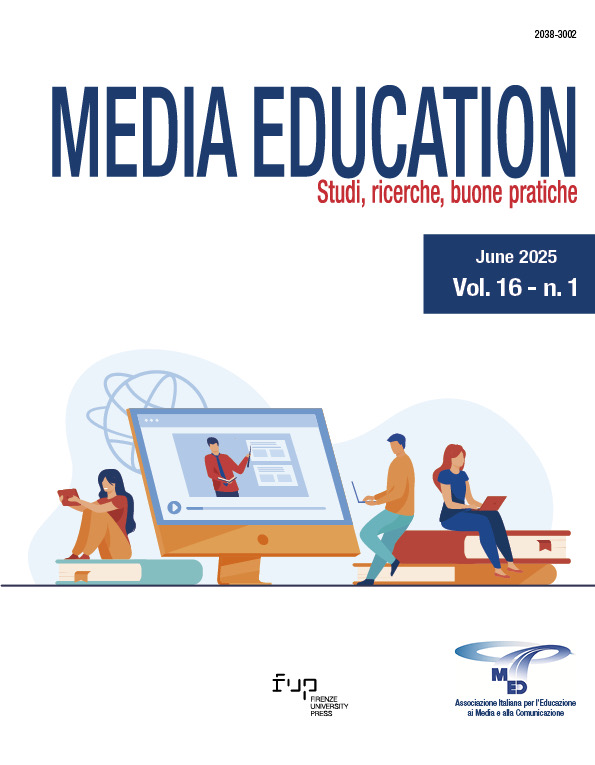Published 2025-06-26
Keywords
- early childhood services,
- media education,
- apps,
- parenting,
- innovative teaching
Copyright (c) 2025 Rosy Nardone

This work is licensed under a Creative Commons Attribution 4.0 International License.
Abstract
Digital environments, particularly touchscreen media, increasingly characterize children’s everyday experiences, with children under three accessing apps, videos, and interactive content, especially in family settings. This creates an ‘educational paradox’: parents alarmed by ‘moral panic’ about digital media oppose tablets in educational contexts while using them in daily life with little critical-creative thinking – essentially as ‘shut-up toys.’ Moreover, connectivity in Italy has developed unevenly with significant regional differences, revealing a complex landscape of access and literacy inequalities across the country, particularly highlighted by the COVID-19 pandemic. This article examines how early childhood educational services play a central role in developing digital culture for children as a literacy right, through their capacity to mediate and familiarize children with complex and creative uses of technological tools in dialogue with other play, reading, and learning materials, and to guide families navigating contradictory approaches, from prohibitionism to uncritical acceptance. Based on research, including the “Tabletti@mo in 0-6” project, we propose guidelines for selecting appropriate apps and promoting positive touchscreen interactions to support educational mediation that centers children’s rights and expressive capacities. We move beyond binary positions to recognize that traditional and digital tools need not be antagonistic.
References
- Balbinot, V., Toffol, G., Tamburlini, G. (2016). Tecnologie digitali e bambini: un’indagine sul loro utilizzo nei primi anni di vita. Medico e Bambino, 35, 631-636. https://csbonlus.org/wp-content/uploads/2020/07/Tecnologie-digitali-e-bambini-versione-pubblicata-MEDICO-E-BAMBINO-23.01.2017.pdf
- Chaudron, S. (2015). Young Children & Digital Technology: A qualitative exploratory study across seven countries. Publications Office of the European Union.
- Cohen, S. (1987). Folk Devils and Moral Panics: The Creation of the Mods and the Rockets. Basil Blackell.
- Connell, S. L., Lauricella, A. R., Wartella, E. (2015). Parental co-use of media technology with their young children in the USA. Journal of Children and Media, 9, 5-21. https://doi.org/10.1080/17482798.2015.997440 DOI: https://doi.org/10.1080/17482798.2015.997440
- Di Bari C. (2016). Educare l’infanzia nel mondo dei media. Il ruolo dell’adulto in famiglia e nei contesti educativi. Edizioni Anicia.
- Di Maggio, P., E. Hargittai, Neuman, W.R., Robinson, J.P. (2001). Social Implications of the Internet. Annual Review of Sociology, 27(1), 307-336. https://doi.org/10.1146/annurev.soc.27.1.307 DOI: https://doi.org/10.1146/annurev.soc.27.1.307
- Dresang, E. T. (1999). Radical Change: Books for Youth in a Digital Age. The Wilson Company.
- Ferranti, C. (2018). Giocare e apprendere con le tecnologie. Esperienze da 0 a 6 anni. Carocci.
- Flewitt, R., Messer, D., Kurcikova, N. (2015). “New Directions for Early Literacy in a Digital Age: The iPad”. Journal of Early Childhood Literacy, 15 (3), https://doi.org/10.1177/1468798414533560 DOI: https://doi.org/10.1177/1468798414533560
- Filograsso, I. (2017). Teaching Reading in a digital age: didactic issues from an european perspective. Metis, VII(1). https://www.metisjournal.it/metis/anno-vii-numero-1-062017-lavoro-liquido.html
- Frey, N., Fisher, D. (2008). Teaching visual literacy: Using comic books, graphic novels, anime, cartoons, and more to develop comprehension and thinking skills. Corwin Press.
- Goodwin, K., Highfield, K. (2012). iTouch and iLearn: an examination of «educational» apps. Paper presented at the Early Education and Technology for Children conference, March 14-16, 2012, Salt Lake City, Utah. https://www.academia.edu/download/26020862/Goodwin_Highfield_2012_iTouch_and_iLearn.pdf
- Grossi, G., Nardone, R., Previtali, G. (2025), Postmedia Education. Visual literacy e media digitali, McGraw-Hill.
- Guerra, L. (2012). Le nuove tecnologie nella Scuola dell’Infanzia. Infanzia, 3, 2012, 163-166.
- ISTAT 2022. Tempo libero e partecipazione culturale. Tra vecchie e nuove pratiche. https://www.istat.it/it/files/2022/09/Tempo-libero-e-partecipazione-culturale_Ebook.pdf
- Mascheroni G., Livingstone S., Dreier M., Chaudron S. (2016). Learning versus play or learning through play? How parents’ imaginaries, discourses and practices around ICTs shape children’s (digital) literacy practices. MEDIA EDUCATION, 7, 261-280. https://doi.org/10.14605/MED721606
- Nardone, R., Pacetti, E., Zanetti F. (2016). “Tabletti@mo: una proposta di ricerca su educazione, prima infanzia e tecnologie digitali”. In Ulivieri, S., Dozza, L. (a cura di) (2016), L’educazione permanente a partire dalle prime età della vita. Franco Angeli. http://ojs.francoangeli.it/_omp/index.php/oa/catalog/book/199
- Neumann, M. M. (2015). Young children and screen time: Creating a mindful approach to digital technology. Australian Educational Computing, 30 (2) https://www.researchgate.net/publication/289379910_Young_children_and_screen_time_Creating_a_mindful_approach_to_digital_technology
- Norman, D. (2013). The design of everyday things. Basic Books.
- Ofcom (2022). Children and parents: Media use and attitudes report. London: Office of Communications https://www.ofcom.org.uk/__data/assets/pdf_file/0024/78513/childrens_parents_nov2015.pdf
- Open Polis (2020). Disuguaglianze digitali. Report luglio 2020 https://www.openpolis.it/wpcontent/uploads/2020/07/Disuguaglianze-digitali.pdf
- Postman N. (1986). La scomparsa dell’infanzia. Armando.
- Ragnedda, M., Muschert, G.W. (2013). The Digital Divide. The Internet and Social Inequality in International Perspective. Routledge. DOI: https://doi.org/10.4324/9780203069769
- Ranieri, M. (2020). Tecnologie per educatori socio-pedagogici. Metodi e strumenti. Carocci.
- Rideout V., Robb M.B. (2020). The Common Sense Census: Media use by kids age zero to eight. Common Sense Media. https://www.commonsensemedia.org/sites/default/files/research/report/2020_zero_to_eight_census_final_web.pdf
- Riva, G. (2014). Nativi digitali. Crescere e apprendere nel mondo dei nuovi media, Il Mulino.
- Rodari, G. (1981). Scuola di fantasia. Riforma della scuola, 5.
- Rodari, G. (1982). Il cane di Magonza. Editori Riuniti.
- Rosin, H. (2013). The Touch-Screen Generation”. The Atlantic. http://www.theatlantic.com/magazine/archive/2013/04/the-touch-screen-generation/309250/
- Sefton-Green, J., Marsh, J., Erstad, O., Flewitt, R. (2016). Establishing a research agenda for the digital literacy practices of young children. A White Paper for COST Action IS1410, 1-37. https://e-space.mmu.ac.uk/624229/
- Tisseron, S. (2016). 3-6-9-12. Diventare grandi all’epoca degli schermi digitali. Editrice La Scuola.
- Valtin R. (2023). The right to digital literacy. Literacy Today, 70-71. https://u.garr.it/l2KCY
- van Deursen, A.J.A.M., van Dijk, J.A.G.M. (2010). “Measuring Internet Skills”. International DOI: https://doi.org/10.1080/10447318.2010.496338
- Journal of Human-Computer Interaction. Volume 26, Issue 10: 891-916
- van Dijk, J.A.G.M. (2005). The Deepening Divide: Inequality in the Information Society. SAGE. DOI: https://doi.org/10.4135/9781452229812
- Wark, M. (1994). The Video Game as an Emergent Media Form. Media Information Australia, 71(1), 21-30. https://doi.org/10.1177/1329878X9407100105 DOI: https://doi.org/10.1177/1329878X9407100105
- Wolf, M. (2018). Lettore, vieni a casa. Il cervello che legge in un mondo digitale, Vita & Pensiero.


